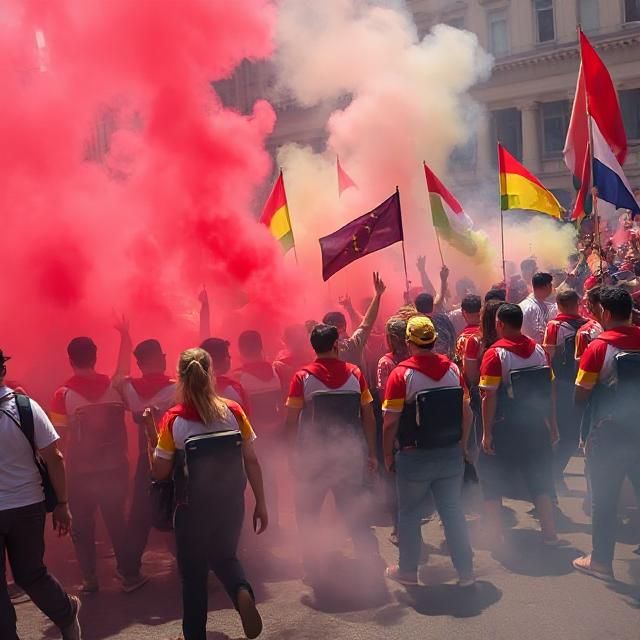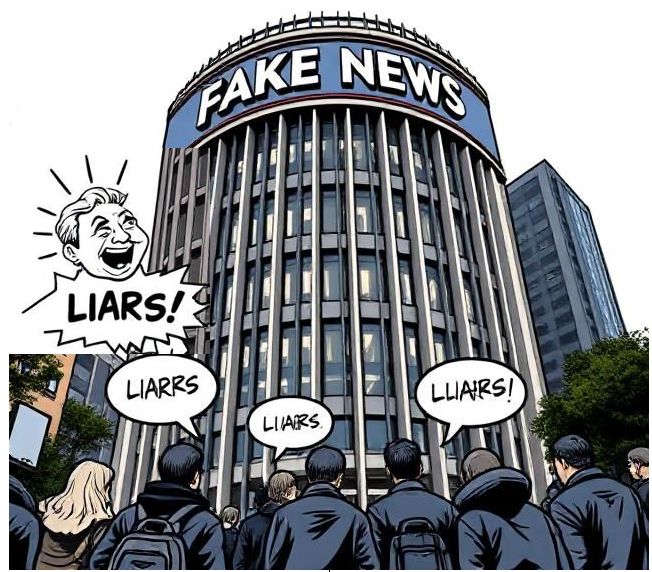images courtesy: http://deepai.org
Ok so it’s well known that mainstream news is basically propaganda from those who seek to misinform you of health products and life in general. I keep myself updated on news networks (the main brands) and as of today I can report that these main-stream-news organizations are 100% enemies of the people. They are your enemy. You probably understand that by now. Whatever you do with that information is up to you.
In this article we lay out what happens and what people have done historically when news organizations become fascist, which is corporations working in conjunction with government to keep themselves operating when they can no longer stay in business for themselves. Ok, so you see this word “fascism” thrown around quite a bit as misinformation. MSM (legacy news) continues to confuse you about what fascism is, from what it is not.
The simple calculation is that when a news organization is funded by government to keep itself in business because the people will no longer do so – that is fascist. Government getting into bed with a corporation to keep them in power against the will of the people based on a good-ol boy deal between Congressmen, state affiliates of the corporate HQ, and paid for activism to collect your tax money to keep them afloat – is fascism. Regardless of how this web is spun.
Of course the news conglomerate will spin all kinds of half-truths into oblivion to keep you confused, stupid, and afraid to do anything about it to keep themselves in business.
Those who own MSM networks are anti-American; anti-you as a person. They care only of misinforming the public about reality, never giving any real knowledge of anything other than propaganda and half truths, confusion and corporate narrative.
They care for the same goals of eugenics as the bad guys that own them and that’s the overall products they push on their networks along with absolute misinformation when it comes to technology, or reporting the news in general. NONE of the mainstream news organizations publish anything on actual medical science, how politics work, new innovation, or simple products that will cure your cancer because they are owned by the very people who don’t want you to know anything about real health, real money, and real power.
Real journalists figured this out long ago and departed these networks to start their own operations, only to be censored, de-banked, and blackmailed.
So you’ll see this constant requirement on these so-called news organizations to continue telling the public they need more controls on misinformation (since they are generating it) and they need more financing from the government for your benefit. “The Democrats’ proposal includes $490.9 million for the Corporation for Public Broadcasting in the next fiscal year.”
So the American people have said “we’re done with you,” but that doesn’t put them out of business as should normally happen directly due to fascism and government personnel being paid off to keep them in business. This fact has already made it’s rounds in government and discussed in Congress concerning the Arabella network. When you hear the word “fascism” the only thing you should think of is corporations that get directly funded by government. Because that’s what it means. Any other story they tell you is just lies. They need government money to stay in business = fascism.
Nationalism is simply a motive of fascism (control the mob), but controlling the narrative of the people is fascism itself when the funnel of information is paid for or sponsored by governing personnel who have been offered favors or special treatment concerning news broadcast. A pay to play game that has been completely diagnosed to date. So all of us investogators are fully aware of the shell game being played here. We are fully aware of the motives of these organizations, their compartments, and their ties to elected officials who play the game of politics.
These organizations have completely abused their positions and have literally become a propaganda wing for extremist corporations who fund terrorist networks and go so far as covering up assassinations while having foreknowledge of terror events that they choose not to inform the public of, nor law enforcement, before an atrocity occurs. These are facts they would love to censor, but it’s impossible to do so now. And they’re traitors anyway in which the U.S. government’s only involvement should be in prosecuting the boards of Directors or CEO’s running these organizations.
The time of watching them operate with impunity is over. If you’re an employee or a sold-out journalist working for these entity, know this – you work for a terrorist network that intends to utilize your talent for debasing, tricking, and manipulating American policy for their terrorist network benefit. These organizations will be treated like ISIS entity: sanctioned, de-funded, broken up, and dismantled.
Ok so that’s the reality you live and you can watch it happen. And these organizations, which were at one time beacons in the American public, a voice if you will of disseminating data to the public, have now become these massively grotesque operations that are anti-American and foreign compromised. And since they are no longer accepted by the American public they choose to keep themselves in business by siphoning your tax money directly through the government – making themselves more of an enemy of Americans than previous, without care. keep in mind the only thing they respect is money and keeping in the lime light. For without such they have no power, no influence, and no policy or mob control.
Ok so that’s it. There is no trust and there shouldn’t be as these companies are not for the American people.
Their goals are to subjugate and misinform the American people in every category of life. If you’re not watching simple local news of events occurring in your town, then you’re enamored with Pharma ads to get you on a new drug, lies about politics, lies about health, lies about infant care and genome testing for eugenics. Lies about virus and sickness, lies about money and retirement, lies about voting and trends. Lies or half truth about everything designed to keep you stupid, ill informed, biased, racist, and ignorant of reality.
Americans have entered a new paradigm where the news agencies of old are totally compromised. They are your enemy now and that’s the way it is regardless of personal opinion. They will continue to solicit your government for YOUR TAX MONEY to keep themselves in business because they are already bankrupt without you. IF you let them continue to do so. The choice is yours.
Find yourself a news source that you agree with – there are plenty out there now.
The main stream parrot news networks are the enemy of the people and there is nothing you can do to change that. What you can do is make sure your Congressmen doesn’t give your money to these organizations to keep them in business. They had their time and now that they are run by terrorist networks, their time is over. Defund them and defund their operations if you want to change America for the better. Start with the evil men and women who are subjugating you through false information and withholding any information to better your lives in every category.
Every person in every State and every legitimate organization in every State can simply overwhelm their congressional office to put these creatures out of business and endeavors are ongoing in every State to do so. That won’t change so we expect pushback by Silicon valley to try to maintain this facade through authoritarian control as offensive measures whittle away their networks and destroy their operations. Have fun because it’s over. Every model I have looked at shows a decline from here and that their only hope of survival is milking your tax dollars to stay alive. Cut them off there and you finish off your enemies.
Many journalists have left MSM and started blogs or websites and are doing news far better than what you grew up with, which as news agencies no longer exists as you think they do. If you want to change your nation for the better, defund legacy main stream news and let them know they are done as an entity. Once these so-called “news” organizations begin to collapse then their other tax-siphon enterprises will begin to fold as they lose control of narrative.
The news agencies have not kept up, they have doubled down on becoming terrorist networks to keep themselves in business.
The government itself will move on to the next “newest trend” and won’t care a bit that these legacy news networks go under because they are not required to care about profit. A government doesn’t need profit to stay in business when you collect taxes, print the fiat or press a button on a keyboard to generate ones and zeros. The government requires news agencies to push their side of the narrative (paid for), but that’s not going to keep a business in the black.
And if a government is funding the entire operations of the business, then it’s no longer a business that can legally trade on NASDAQ or NYSE, as you can’t be a State certified business and part of the government at the same time while claiming your a taxed business entity. Ok, so do what you want as we unravel your schemes in courts of law in every State.
The mega-news people who care about saving their business are those deceiving you and getting wealthy off your dime while trying to destroy your family. That’s it in a nutshell.
The government is smart enough to know, they have to flow with the times, and when the people move on to something else, government must also keep up or stay ahead of the game. The idea is “keep up, or get out of the way.”
Besides, various groups in government are fully aware that these news networks we’re working them along with foreign investors, playing both sides of the fence – taking money from governing entity, while doing the bidding of other investors that competed, or was opposite of what government expected. Ok, so they played both sides of the fence. MSM Newsies pretend to be patriots when it makes them money to do so, but they sell out whoever they want (politicians or citizens) based on who pays the most at any given time, or dependent on what a foreign nation requires them to do at any given time.
The news agencies have not kept up, they have doubled down on becoming EXPOSED terrorist networks to keep themselves in business. Exposed means your news personnel have been investigated fully – network to network, peer to peer across the board. And that’s the way the cookie crumbles.
Information Overload and Delirium:
The regime may flood the information space with a mix of true and false content to confuse people so thoroughly that they become cognitively exhausted and politically apathetic. This tactic, known as information gaslighting or “delirium,” causes people to give up trying to discern truth from lies, reducing public resistance to the regime’s narrative.
Suppressing Dissent and Whistleblowers:
Authoritarian regimes harshly punish journalists, whistleblowers, and activists who try to expose the truth, using imprisonment, intimidation, legal harassment (such as libel lawsuits), or even violence to silence critics and discourage others from speaking out, including assassination and changing law making forms of speech illegal.
Control and Censorship of Media:
The government tightens control over all media outlets, restricts foreign or independent media ownership, and uses internet censorship systems (e.g., firewalls, content removal) to prevent the spread of alternative narratives and independent information.
Disinformation Campaigns:
The regime disseminates disinformation through coordinated state-controlled media and digital influence operations, using fabricated stories, distorted facts, and repetition to legitimize false narratives and crowd out independent voices.
Legal and Political Pressure:
By using the legal system and regulatory powers, governments restrict press freedoms, impose fines, revoke licenses, and create an atmosphere of fear to maintain media compliance and suppress dissenting messages.
Manipulation of Social Media and Online Spaces:
Authoritarian regimes exploit social media by amplifying pro-regime messages, deploying bots and fake accounts, and systematically undermining oppositional narratives to maintain control over public opinion.
Encouraging Political Apathy:
By creating an environment of confusion and fear, regimes aim to make citizens politically apathetic and disengaged from activism or resistance, which reduces threats to the government’s power.
Legal Measures:
-
Strategic Lawsuits Against Public Participation (SLAPPs): Frivolous and costly lawsuits targeting journalists to intimidate, harass, and drain their resources, discouraging critical reporting and free speech.
-
Criminal Defamation and Insult Laws: Laws criminalizing defamation or insult of public officials or entities, which can lead to arrest, heavy fines, and imprisonment, creating a chilling effect on investigative journalism.
-
National Security and Anti-Terrorism Laws: Vaguely worded laws criminalizing acts like “espionage,” “treason,” or “supporting terrorism” are used to prosecute and imprison journalists reporting on sensitive topics or dissenting narratives.
-
Financial Crime Charges: Authorities often use charges like tax evasion, fraud, or money laundering to discredit, intimidate, and financially cripple journalists and independent media outlets.
-
Foreign Agent Laws: Laws requiring registration and reporting from entities receiving foreign funding, used to stigmatize and restrict civil society organizations and journalists working with international partners.
- Cancelling visas and passports from critics, deportations, and false accusations to detain and/or intimidate.
-
Media Regulation and Licensing: Legal controls over media ownership and operational licenses used to revoke or deny access to platforms for independent journalists.
Extralegal Measures:
-
Intimidation, Harassment, and Violence: Physical attacks, threats, arrest without due process, and harassment to suppress journalists outside formal legal frameworks.
-
Surveillance and Coercion: Monitoring and pressuring journalists through invasive surveillance and information gathering to discourage critical coverage.
-
Social and Professional Isolation: Using smear campaigns and delegitimizing journalists publicly to isolate them from civil society and professional networks.
Regimes use a variety of sophisticated techniques to surveil and harass journalists, including:
-
Spyware and Digital Surveillance: Governments deploy advanced commercial spyware (e.g., NSO Group’s Pegasus) to infect journalists’ devices remotely, enabling full access to their communications, location, microphone, and camera. This allows them to monitor reporters’ sources, conversations, and plans covertly.
-
Phishing and Account Hacking: Targeted phishing campaigns trick journalists into revealing login credentials for email, social media, or cloud accounts, giving regimes the ability to access sensitive information and disrupt journalistic activities.
-
Social Media Manipulation and Disinformation: State actors use social media platforms to conduct disinformation campaigns, spread propaganda, intimidate journalists with coordinated harassment, and isolate them from public support.
-
Physical and Digital Tracking: Authorities monitor journalists’ physical movements via location data from telecommunications networks or other surveillance technologies, alongside cyber tracking of digital footprints to control and intimidate.
-
Online Harassment and Cyberattacks: Journalists face state-sponsored trolling, doxxing, threats, and distributed denial-of-service (DDoS) attacks aimed at shutting down independent news sites and silencing dissidents.
These surveillance and harassment techniques severely undermine journalists’ ability to report freely, often forcing self-censorship and depriving the public of independent information.
Together, these legal and extralegal measures form a comprehensive framework used by governments and powerful actors to silence independent journalists and critics, curtail freedom of expression, and maintain control over public narratives.
These combined measures function systematically to suppress free expression, control public narratives, and maintain power by silencing independent journalism and criticism in many parts of the world. In short, an authoritarian government doubling down on state-controlled news sources after being exposed would likely combine overwhelming and confusing misinformation, coercive suppression of critics, heavy censorship, disinformation campaigns, and manipulation of digital platforms to maintain control and discourage public resistance to their lies.
RESISTANCE –

The likelihood of a society under authoritarian or corporate government control rebelling, rioting, or starting a revolution after discovering pervasive deception varies widely depending on multiple socio-political factors. Statistically, it is more common for authoritarian regimes to survive such crises of legitimacy than for mass uprisings to succeed.
Several factors influence these outcomes:
-
Authoritarian regimes have increasingly become effective at co-opting institutions, manipulating elections, suppressing dissent, and controlling information, which strengthens their resilience against rebellion or revolution.
-
Public support for authoritarian rule remains surprisingly significant in many countries, with median support around 31% in surveys across 24 nations, and higher in certain regions, implying some segments accept or tolerate authoritarian control, reducing the probability of mass revolt.
-
Successful large-scale revolutions or uprisings tend to arise only when various conditions align: severe economic hardship, widespread regime illegitimacy, loss of elite support for the regime, and capable, organized opposition. Even then, outcomes vary, and many movements are violently suppressed.
-
Authoritarian regimes often resort to preemptive repression — breaking up groups, violent crackdowns, infiltration, disinformation, and co-optation of opposition — which statistically significantly lowers the chance of successful rebellion.
-
Social trust and voluntary compliance also impact resistance; regimes with higher public trust face more challenges to enforcement, while distrust amplifies unrest but does not guarantee revolution.
Historically, during World War II, the French Resistance was a diverse collection of groups united in fighting the Nazi occupation and the collaborationist Vichy regime in France. They engaged in guerrilla warfare, sabotage of German military infrastructure, publication of underground newspapers, and intelligence gathering to aid the Allied forces. Their efforts notably contributed to the success of the Allied invasion of Normandy (D-Day) in June 1944 and the subsequent liberation of France.
Despite representing only about 1-3% of the population, the Resistance’s activities were crucial in undermining German operations and maintaining French morale. The Resistance movement included people from all parts of French society and political backgrounds, including communists, Catholics, liberals, and others, highlighting a broad-based opposition to the occupation.
Polish resistance to Nazi occupation during World War II was also significant though different in scale and context. The Polish underground state included the Home Army (Armia Krajowa), one of the largest resistance organizations in occupied Europe, loyal to the Polish government-in-exile. They conducted sabotage, intelligence operations, and open uprisings such as the Warsaw Uprising in 1944, fighting fiercely against the Nazis despite brutal repression. Polish resistance also encompassed various political factions but was deeply connected to nationalistic aims of sovereignty and liberation.
The French and Polish resistance movements demonstrate that even under brutal authoritarian occupation and intense repression—including censorship, surveillance, and violence—organized resistance can emerge and impact outcomes significantly. However, such resistance required clandestine organization, external support (e.g., Allied backing), and a broad social base willing to risk severe reprisals. Their success was not assured but was facilitated by factors like external military pressure, cohesive leadership, and widespread support.
For fictional authoritarian regimes using modern surveillance, censorship, and repression as discussed, these historical examples show that while rebellion is possible, it often depends on factors like resource availability, external assistance, the regime’s strength, and societal resilience. Statistical probabilities of successful revolt thus must consider these conditions, which historically have been rare and costly but not impossible.
In essence, the French and Polish resistance highlight both the incredible risks and potential for uprisings and insurgency under authoritarian control, illustrating a nuanced interplay between repression, resistance, and external factors driving political outcomes.
While public outrage or non-compliance can lead to protests or riots, the probability of successful revolution against entrenched and well-resourced authoritarian or corporatist overseers is relatively low statistically. A regime’s capacity for repression, manipulation, and control tends to prevent large-scale successful uprisings more often than not. Nonetheless, localized unrest, spontaneous protests, or small-scale resistance remain possible and sometimes act as long-term pressures on regime stability.
REGIME FLIGHT –

Examining historic monarchy, when attempting to flee the mob, grants clues to effectual outcome of how to position ruling families inducing evasion or flight to abandon untenable positions of movement. The French monarchy’s attempted flight during the Revolution, known as the Flight to Varennes in June 1791, was a pivotal event leading to their eventual overthrow.
Their escape was thwarted primarily by a series of missteps and bad luck. The royal family traveled in a conspicuous heavy coach instead of splitting up in faster vehicles, delaying progress. At Sainte-Menehould, the King was recognized by the local postmaster, Jean-Baptiste Drouet, who alerted authorities. The royal party was intercepted and arrested at Varennes, about 31 miles short of their destination. Loyal troops were nearby but refused to attack out of fear for the royal family’s safety, leaving the king and his family vulnerable to capture and return to Paris.
This failed flight was traumatizing for revolutionary France, confirming the King’s disloyalty to the Revolution and sparking widespread outrage. It galvanized republican sentiments, leading to the erosion of support for a constitutional monarchy and culminating in the King’s deposition and execution in 1793. The incident made clear that the monarchy could not coexist with revolutionary ideals and hastened the regime’s overthrow.
The monarchy was physically cut off by close surveillance and political containment, failed due to poor planning and recognition by locals, and was overthrown because the failed escape underscored their opposition to revolutionary change, permanently damaging their legitimacy.
The underlying will and beliefs of the people were pivotal in forcing the monarchy’s change and eventual overthrow during the French Revolution. The monarchy’s legitimacy depended heavily on the perception that King Louis XVI was aligned with the people’s interests and revolutionary ideals. When the King initially accepted revolutionary changes and constitutional limits, he retained a degree of popular support as someone who could reconcile tradition and reform.
However, this fragile acceptance waned as the King’s actions—such as his failed flight to Varennes—demonstrated his opposition to revolutionary principles and his willingness to abandon the people’s cause. This breach of trust was perceived as a rejection of the new political reality the people demanded: liberty, equality, and democratic governance. The people’s will shifted from conditional support of a constitutional monarchy to outright demand for the abolition of royal rule, culminating in the monarchy’s overthrow and the establishment of the republic.
In short, the monarchy had to genuinely accept and embody revolutionary thinking to maintain legitimacy and avoid overthrow. When it became clear that Louis XVI opposed or tried to undermine this, the revolutionary will of the people overcame old loyalty, forcing radical change—showing how popular belief and legitimacy are crucial in political power dynamics.
ATMOSPHERE OF CHANGE –

Revolutionary thinking during the French Revolution was ingrained into the public largely through widespread and multifaceted propaganda efforts. Key unstoppable means included:
-
Newspapers, Pamphlets, and Posters: Revolutionary groups produced mass-distributed print media that disseminated ideas of liberty, equality, and fraternity. These materials often ridiculed the monarchy and aristocracy, criticized social inequalities, and called for active participation in the revolution.
-
Political Cartoons and Caricatures: Visual satire was used to mock the ruling classes and spread revolutionary messages widely, often understandable even to the illiterate. For example, figures like King Louis XVI and Queen Marie Antoinette were demonized in caricatures to erode their legitimacy.
-
Songs and Music: Revolutionary songs like “Ça Ira” and “La Carmagnole” became popular anthems to rally the working classes and spread revolutionary zeal through public singing, especially effective among the largely illiterate populace.
-
Public Speeches, Demonstrations, and Festivals: Orators and agitators gave speeches in public squares, and large communal events promoted revolutionary values and solidarity. These often combined education, entertainment, and political mobilization. (Charlie Kirk for example had the ability to sway large audience publicly).
-
Symbolism in Clothing and Public Displays: The sans-culottes, revolutionaries known for their distinctive trousers (long pants vs. aristocratic knee-breeches), became symbols of the revolution’s democratic and egalitarian ideals. Colors and badges like red, white, and blue cockades visually signaled identity and loyalty to the cause.
-
Everyday Objects as Propaganda: Items like coins, playing cards, and household goods were redesigned to carry revolutionary symbols and messages, embedding the ideals physically into people’s daily lives.
These diverse propaganda methods helped spread revolutionary thinking widely and deeply, overcoming barriers like illiteracy, government crackdown through violence and social divisions, thus fueling popular support and commitment to overthrowing hated régimes.
Summary of Discussion:
The likelihood of public rebellion or revolution depends heavily on social, political, and economic conditions, the regime’s capacity for repression, and external support for resistance.
Historical examples like the French and Polish resistance against Nazi occupation illustrate that organized opposition can emerge under extreme repression but requires broad social support, external aid, and effective leadership. The French Revolution further demonstrated the power of popular will and revolutionary thinking to overthrow entrenched monarchy – a process deeply influenced by propaganda through newspapers, posters, songs, and public events to ingrain new political ideals.
The monarchy’s failure to adapt and its attempted flight eroded its legitimacy, leading to its overthrow as the people’s allegiance shifted decisively to revolutionary ideals.
Advice for Reclaiming Control from Authoritarian Governments:
-
Build Broad Social Consensus: Successful resistance starts by uniting diverse segments of society with shared goals, fostering solidarity across class, ethnic, and political lines.
-
Spread Truth and Counter Propaganda: Use all available media, including grassroots and digital platforms, to inform and educate the public about the regime’s abuses, promoting critical thinking and awareness.
-
Organize Peaceful Public Actions: Demonstrations, strikes, and other forms of collective nonviolent resistance can disrupt authoritarian control without playing into narratives of chaos.
-
Leverage External Support: International networks can provide resources, political pressure, and safe havens for activists to sustain movements.
-
Protect Privacy and Security: Use secure communication tools and practices to avoid surveillance and repression by authorities.
-
Prepare for Long-Term Commitment: Regime change rarely happens overnight; persistence, strategic planning, and adaptability are essential.
-
Strengthen Institutions: Advocate for rule of law, independent judiciary, free press, and democratic governance structures to prevent future authoritarian relapse.
The French Revolution shows that when a government loses legitimacy in the eyes of its people and fails to recognize their evolving demands, it becomes vulnerable. Public belief and widespread political education are critical for mobilizing meaningful change. History encourages those living under authoritarianism that though risks and repression exist, sustained collective effort rooted in shared ideals can reclaim control and build more just societies, while eradicating or causing unethical regimes to flee.
The question remains whether governments in the West will keep funding fake news outlets over alt-news or small business entity news (journalists who broke off from the main) or will they keep funding the terrorist organizations that are anti-people, pro Clima-Con, and pro-Eugenics?
It doesn’t take much on part of a governing entity to basically destroy operations unilaterally once it’s decided to do so by the people and/or the DOJ. President Trump can be seen as taking unilateral action against his enemies, their news networks and affiliates. Germany as litmus and future forecasts display open rebellion towards news agencies similar to
Keeping an eye on the narrative from social media’s top 10:
Largest Social Media Companies (2025)
| Rank | Company | Leading Platforms | Combined Monthly Active Users (MAUs) |
| 1 | Meta Platforms, Inc. | Facebook, Instagram, WhatsApp, Messenger, Threads | Over 8 billion (cumulative) |
| | Facebook remains the world’s largest individual platform with about 3.07 billion users. | ||
| 2 | Alphabet Inc. | YouTube | 2.7 billion |
| | YouTube is the top video-sharing platform globally and the 3rd most used social site overall. | ||
| 3 | ByteDance Ltd. | TikTok, Douyin | 2.61 billion |
| | TikTok has 1.84 billion users globally, while Douyin leads in China with 770 million. | ||
| 4 | Tencent Holdings Ltd. | WeChat (Weixin), Qzone, QQ | Around 2.4 billion |
| | WeChat dominates China’s social media ecosystem with 1.39 billion active users. | ||
| 5 | Telegram LLC | Telegram | 1 billion |
| | Telegram’s encrypted messaging and group-sharing tools boosted its rapid global growth. | ||
| 6 | Snap Inc. | Snapchat | 900 million |
| | Snapchat continues to grow among younger audiences with strong AR features. | ||
| 7 | Rakuten Group | Viber | 820 million |
| | Popular in Eastern Europe and parts of Asia for voice and text communication. | ||
| 8 | Kuaishou Technology | Kuaishou | 710 million |
| | Douyin’s main Chinese rival in short video content. | ||
| 9 | Microsoft Corp. | LinkedIn, Microsoft Teams | 630 million |
| | Gains are driven by business and professional social networking. | ||
| 10 | Discord Inc. | Discord | 200 million |
| | Focuses on gaming, education, and niche online communities. |
This data continues to tell me, if you make a disruptive social media app you’re going to make alot of money from the top 10 willing to buy you out and stay in business. As Meta and the like have been doing since inception. This trend will continue for at least the next two years and will accelerate in fierce competition.
Ripe pickings to harvest $$$ from these companies as they panic at losing control. It’s definitely a sellers market when it comes to app development.
And so we can see at anytime what is trending among the youth as “rebellion” or “narrative acceptance,” disinformation taking hold, or whether the mob is revolting in real time. It is also why we have this thing called transparency, which tells us the data being uploaded to Facebook, TikTok or WeChat is visible to everyone, not just internal database. Ok let’s put that nonsense behind us then.
This data, very soon commercially, will be spider crawled in a new way in which NO DATA can hide. And the use of photonic laser chips allow entire internet stream rates to archive everything in one day – daily. I’ll translate that for you. It means the average code guy using agentics will pluck every piece of data desired DAILY and this changes the dynamics of a Facebook, etc,. As these entities can be used to barter seed series stock with very little effort. Due to the fact they have no choice if they want to remain a player in the network.
Any fool will have access to every secret from the internet, not based on hacking or having any real coding knowledge, but because AI agentic technology allows this regardless of whatever caps a government puts on things. It’s outbreak territory when it comes to technology now according to Moore’s Law. And so the new social media will not be the “internet of things.” That’s the past and well understood as overthrown by commercial corporatism. So new systems have been built and will be bartered to compete.
These large tech companies, the Silicon valley control if you want to call it that, have no choice but to compete and purchase space (not stakeholderism) in sovereign structures built in what you could call cloud space, which is unlimited. Paying for a gigabyte drive from Radio Shack or Walgreens as a comparison, is similar to digging a sulfuric water well for one household, or the choice of having access to an endless ocean of pure water. Which do you think the population will choose the world over?
Bandwidth, disk space, data usage for a server – all a thing of the past.
So the men who have built these mighty Empires that control stock companies and boards of Directors. They did not come up with the tech which runs their companies. They merely use the tech to keep things going. And the tech they are using across a broad interface is now completely obsolete. Just like any business they will have to purchase the new tech that comes out or try to compete with it.
A news syndicate monopoly is over. I hope you enjoyed your time with it.
As these systems erode and lose relevance to newer, unseen social tech, governments will scramble to take hold of their slice of the pie to continue controlling narrative, or succumb to technology – whichever occurs first.
This synthesis emphasizes that thoughtful, informed resistance combined with societal cohesion and strategic action offers the best chance of overcoming authoritarian control, as history and social science suggest.


